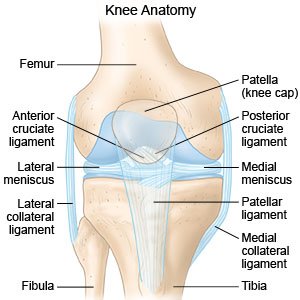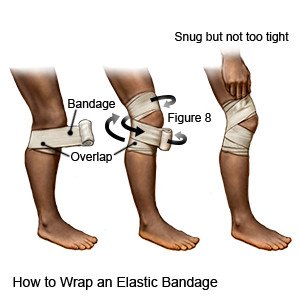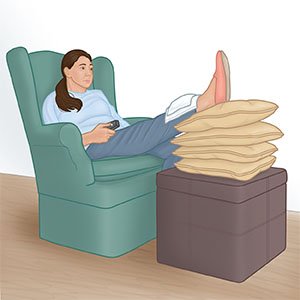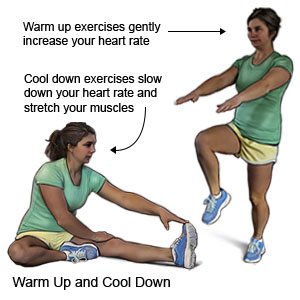Knee Sprain
Medically reviewed by Drugs.com. Last updated on Apr 2, 2024.
What is a knee sprain?
A knee sprain is a stretched or torn ligament in your knee. Ligaments support the knee and keep the joint and bones in the correct position. A knee sprain may involve one or more ligaments.
 |
What increases my risk for a knee sprain?
- Not using the correct shoes or protective gear during activity
- Not warming up or stretching before exercise
- Too much exercise at one time, or a sudden increase in exercise
What are the signs and symptoms of a knee sprain?
- Stiffness or decreased movement
- Pain or tenderness
- Painful pop that you can hear or feel
- Swelling or bruising
- Knee that buckles or gives out when you try to walk
How is a knee sprain diagnosed?
Your healthcare provider will ask about your injury and examine you. Tell him or her if you heard a snap or pop when you were injured. Your provider will check the movement and strength of your joint. You may be asked to move the joint. You may also need any of the following:
- An x-ray, CT scan or MRI may show the sprain or other damage. You may be given contrast liquid to help your injury show up better in the pictures. Tell the healthcare provider if you have ever had an allergic reaction to contrast liquid. Do not enter the MRI room with anything metal. Metal can cause serious injury. Tell the healthcare provider if you have any metal in or on your body.
- Arthroscopy is a procedure to look inside your joint with a scope. The scope is a long tube with a magnifying glass, a camera, and a light on the end.
How is a knee sprain treated?
Treatment depends on the type and cause of your knee sprain. You may need any of the following:
- NSAIDs , such as ibuprofen, help decrease swelling, pain, and fever. This medicine is available with or without a doctor's order. NSAIDs can cause stomach bleeding or kidney problems in certain people. If you take blood thinner medicine, always ask your healthcare provider if NSAIDs are safe for you. Always read the medicine label and follow directions.
- Acetaminophen decreases pain and fever. It is available without a doctor's order. Ask how much to take and how often to take it. Follow directions. Read the labels of all other medicines you are using to see if they also contain acetaminophen, or ask your doctor or pharmacist. Acetaminophen can cause liver damage if not taken correctly.
- Prescription pain medicine may be given. Ask your healthcare provider how to take this medicine safely. Some prescription pain medicines contain acetaminophen. Do not take other medicines that contain acetaminophen without talking to your healthcare provider. Too much acetaminophen may cause liver damage. Prescription pain medicine may cause constipation. Ask your healthcare provider how to prevent or treat constipation.
- A support device such as a splint or brace may be needed. These devices limit movement and protect the joint while it heals. You may be given crutches to use until you can stand on your injured leg without pain.
- Physical therapy may be needed. A physical therapist teaches you exercises to help improve movement and strength, and to decrease pain.
- Surgery may be needed if other treatments do not work or your strain is severe. Surgery may include a knee arthroscopy to look inside your knee joint and repair damage.
How can I manage a knee sprain?
- Rest your knee and do not exercise. Do not walk on your injured leg if you are told to keep weight off your knee. Rest helps decrease swelling and allows the injury to heal. You can do gentle range of motion exercises as directed to prevent stiffness.
- Apply ice on your knee for 15 to 20 minutes every hour or as directed. Use an ice pack, or put crushed ice in a plastic bag. Cover the bag with a towel before you apply it. Ice helps prevent tissue damage and decreases swelling and pain.
- Apply compression to your knee as directed. You may need to wear an elastic bandage. This helps keep your injured knee from moving too much while it heals. It should be tight enough to give support but so tight that it causes your toes to feel numb or tingly. Take the bandage off and rewrap it at least 1 time each day.

- Elevate your knee above the level of your heart as often as you can. This will help decrease swelling and pain. Prop your leg on pillows or blankets to keep it elevated comfortably. Do not put pillows directly behind your knee.

How can I prevent another knee sprain?
Exercise your legs to keep your muscles strong. Strong leg muscles help protect your knee and prevent strain. The following may also prevent a knee sprain:
- Slowly start your exercise or training program. Slowly increase the time, distance, and intensity of your exercise. Sudden increases in training may cause another knee sprain.
- Wear protective braces and equipment as directed. Braces may prevent your knee from moving the wrong way and causing another sprain. Protective equipment may support your bones and ligaments to prevent injury.
- Warm up and stretch before exercise. Warm up by walking or using an exercise bike before starting your regular exercise. Do gentle stretches after warming up. This helps to loosen your muscles and decrease stress on your knee. Cool down and stretch after you exercise.

- Wear shoes that fit correctly and support your feet. Replace your running or exercise shoes before the padding or shock absorption is worn out. Ask your healthcare provider which exercise shoes are best for you. Ask if you should wear shoe inserts. Shoe inserts can help support your heels and arches or keep your foot lined up correctly in your shoes. Exercise on flat surfaces.
When should I seek immediate care?
- Any part of your leg feels cold, numb, or looks pale.
When should I call my doctor?
- You have new or increased swelling, bruising, or pain in your knee.
- Your symptoms do not improve within 6 weeks, even with treatment.
- You have questions or concerns about your condition or care.
Care Agreement
You have the right to help plan your care. Learn about your health condition and how it may be treated. Discuss treatment options with your healthcare providers to decide what care you want to receive. You always have the right to refuse treatment. The above information is an educational aid only. It is not intended as medical advice for individual conditions or treatments. Talk to your doctor, nurse or pharmacist before following any medical regimen to see if it is safe and effective for you.© Copyright Merative 2024 Information is for End User's use only and may not be sold, redistributed or otherwise used for commercial purposes.
Learn more about Knee Sprain
Care guides
Further information
Always consult your healthcare provider to ensure the information displayed on this page applies to your personal circumstances.
